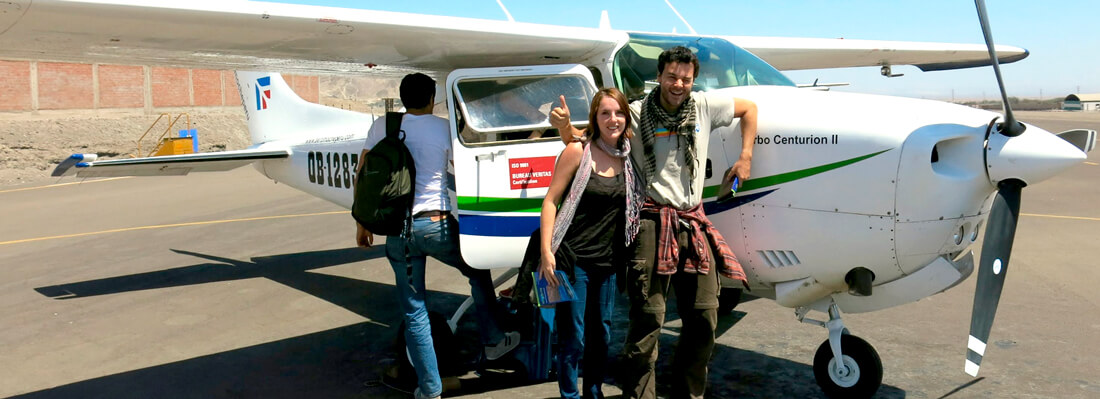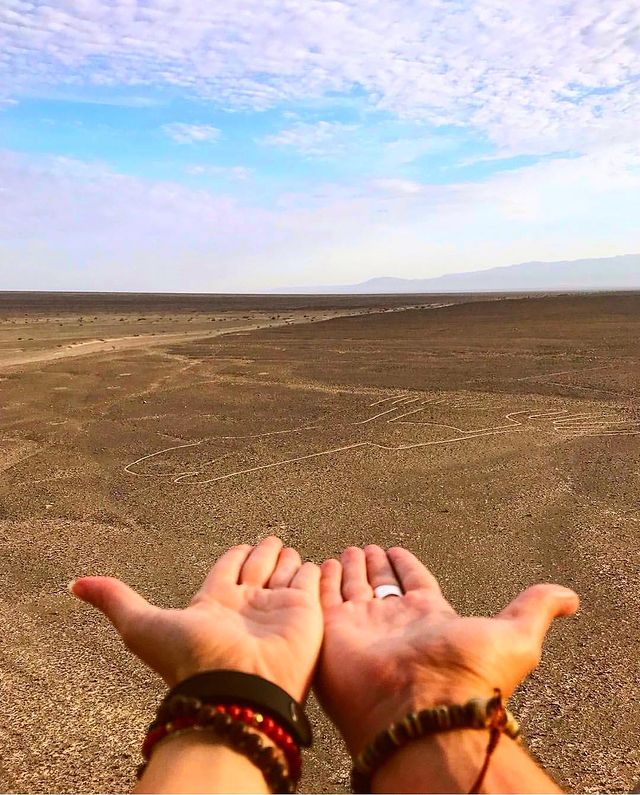In Perú, between the towns of Nazca and Palpa, are the Nazca Lines, one of the most enigmatic archaeological mysteries of our planet. What on the ground looks like a labyrinth of paths traced on the ground, from a bird’s eye view it composes gigantic figures that represent geometric shapes, animals, plants and humans.
Because the work can only be seen from above (either from the surrounding hills or from the air), the purpose and meaning of the Nazca Lines in Perú has given rise to the most diverse theories, since it is only about Ritual paths until the figures are related to the visits of aliens to Earth.
What are the Nazca Lines?

Nazca lines 
Nasca lines in Peru
Many people ask: What are the Nazca Lines? Well, the Nazca Lines are a series of roads traced on the earth’s surface that occupy a vast extension located in the Nazca desert, located in the department of Ica in Peru.
It is about 300 geoglyphs (drawings drawn on the ground) in the shape of geometric, anthropomorphic, zoomorphic and phytomorphic figures, with lengths of between 50 and 300 meters, which extend over an area of 450 square meters. The width of the lines ranges between 40 and 210 centimeters, and their depth never exceeds 30 centimeters.
They were traced by removing materials from the earth’s surface, pebbles of a reddish color caused by oxidation, revealing a paler earth, which is the one that draws the shapes that can be seen from above. The work has been conserved practically intact throughout the centuries thanks to the fact that it hardly rains in the area, which has favored its preservation.
Given the precision of the shapes taking into account their enormous proportions, it is believed that the authors were able to use grids made with ropes and stakes to translate the drawings to scale. Taking into account that at ground level it is not possible to perceive whether the figures are correctly drawn or not, it is thought that the construction had to be directed from a high place.
Among the most striking and popular geoglyphs are the following:
The hummingbird in Nazca Lines, whose image you can see on the cover of this report. The hummingbird in Nazca Lines stands out for its harmonic dimensions. Between its two wings there is a distance of about 66 meters. According to the historian María Rostworowski, the hummingbird in Nazca Lines is a tribute to a flying god to avoid the absence of rain.
The monkey has a spiral-shaped tail and nine fingers, and its size is 135 meters. It was discovered by María Reiche, who considers that the tail and the hands of the geoglyph are directly related to the constellations and the rainy season. It is believed to represent the Big Dipper.
The spider is another of the most characteristic figures of Nazca. It is about 46 meters long and is believed to have been drawn to avoid droughts.
The giant bird is 300 meters long and 54 wide. It has a snake-shaped neck and its beak points directly towards the point where the sun rises in June. Researchers consider that it is the “Announcer of Inti Raymi”, the solar festival of the Incas.
The man-owl, popularly known as the astronaut in Nazca Lines, is a strange anthropomorphic figure that has become one of the best known of the Nazca Lines. Pseudo-archaeological theories defend that astronaut in Nazca Lines is a figure with a diving suit or helmet and rely on it to explain that the geoglyphs were drawn as messages for aliens.
The whale is about 60 meters wide and 20 high. Researchers believe it symbolizes a marine deity.
History of the Nazca Lines
American anthropologist Paul Kosok was one of the first researchers to hypothesize about the origin of the Nazca Lines. According to his theory, they were traced by the Nazca civilization, an archaeological culture of Ancient Peru, which developed in the valleys of the current department of Ica between 300 BC and 600 AD.
In addition, the hypothesis is reinforced by the coincidence of the drawings of the roads with those that appear in the ceramics of the Nazca culture.
The first testimonies of the existence of the Nazca Lines date from the year 1547. The Spanish historian and chronicler Pedro Cieza de León explained that he had seen “signs in some parts of the Nazca desert.” However, these claims were not investigated at the time and were forgotten.
Although the shapes can be seen from the nearby hills, it was the Peruvian pilots who warned of their presence. In 1929 the Peruvian archaeologist Julio César Tello began to study them, and the same year Paul Kosok began his research.
The North American anthropologist was studying the lines until the 1950s, and was in charge of finding out that they date from 550 AD using the Carbon-14 technique.
His partner, the German María Reiche Neumann, was the greatest researcher of the mysterious forms and dedicated her life to their study, conservation and dissemination. Thanks to her work, the Nazca Lines were declared Cultural Heritage of Humanity by UNESCO in 1994.
Meaning of the Nazca Lines
The purpose and meaning of the Nazca Lines in Perú is one of the great enigmas that those who have investigated them have faced. And, why would the Nazca want to draw figures on the earth that can only be seen from above?
Some consider them simple ways of worship, others believe that they are a gigantic calendar, others that it is some kind of ritual to invoke the rains… We summarize the main theories below.
The Peruvian archaeologist Julio César Tello, the first to study them, described them as a series of “sacred roads”. Later, in 1932, Toribio Mejía Xesspe pointed out that the lines were part of a disappeared cult and that they were nothing more than roads with a religious sense.
Paul Kosok’s performance was different. The American anthropologist defined them as a great astronomical book, “the largest-scale calendar in the world.”
In the same vein, the conclusions of María Reiche Neumann indicate that the shapes are a gigantic solar and lunar calendar that Peruvian astronomers used to make forecasts about the harvest and the rains.
The researcher thought that the purpose of the Nazca Lines in Perú was to point to the sun and other celestial bodies with their figures, and they are also related to the solstice and the equinox to establish the solar calendar.
The Swiss journalist and writer Henri Stierlin published in 1983 a book entitled “Nazca. The solution of an archaeological enigma”, which offered a new theory about the meaning of the drawings of the Peruvian desert. According to the author, the lines functioned as looms (in Nazca fabrics with a size greater than 20 meters have been found) and the figures had a protective character.
The German archaeologist Markus Reindel and the Peruvian Johny Isla put forward another theory. According to them, the geoglyphs were drawn as part of a ritual invocation of the rains, since the area lacked sufficient water resources and was punished with long periods of drought.
In 2015, researchers from Yamagata University in Japan presented the results of their study at the annual convention of the American Archaeological Society, noting that they had solved the mystery of the Nazca lines.
After analyzing the different images, the team determined that there are four different types of geoglyphs that are grouped into different routes, all bound for the pre-Inca city Cahuachi, capital of the Nazca culture and center of pilgrimage.
According to Japanese researchers, the Nazca Lines in Perú were traced by at least two cultures, as two different types of techniques and symbolisms are clearly distinguished. In addition, they explain that the purpose of the geoglyphs was changing over time. Although at the beginning they were built for worship purposes, later they were located on the road to Cahuachi so that the pilgrims could admire them.
How to see the Nazca Lines in Perú?
The simplest thing is to spend the night before the visit in the city of Nazca, to get up early and be able to make the flight early. You can book the Nazca Lines Tour here.
Most accommodations will manage the flight reservation for you at no additional cost, and this usually includes pick-up and return to the accommodation by the company that makes the flights, so it is the most comfortable. You can also go directly by taxi to the María Reiche aerodrome, where all the airlines that perform the overflights have a counter, and hire the flight with the one that best suits you.










